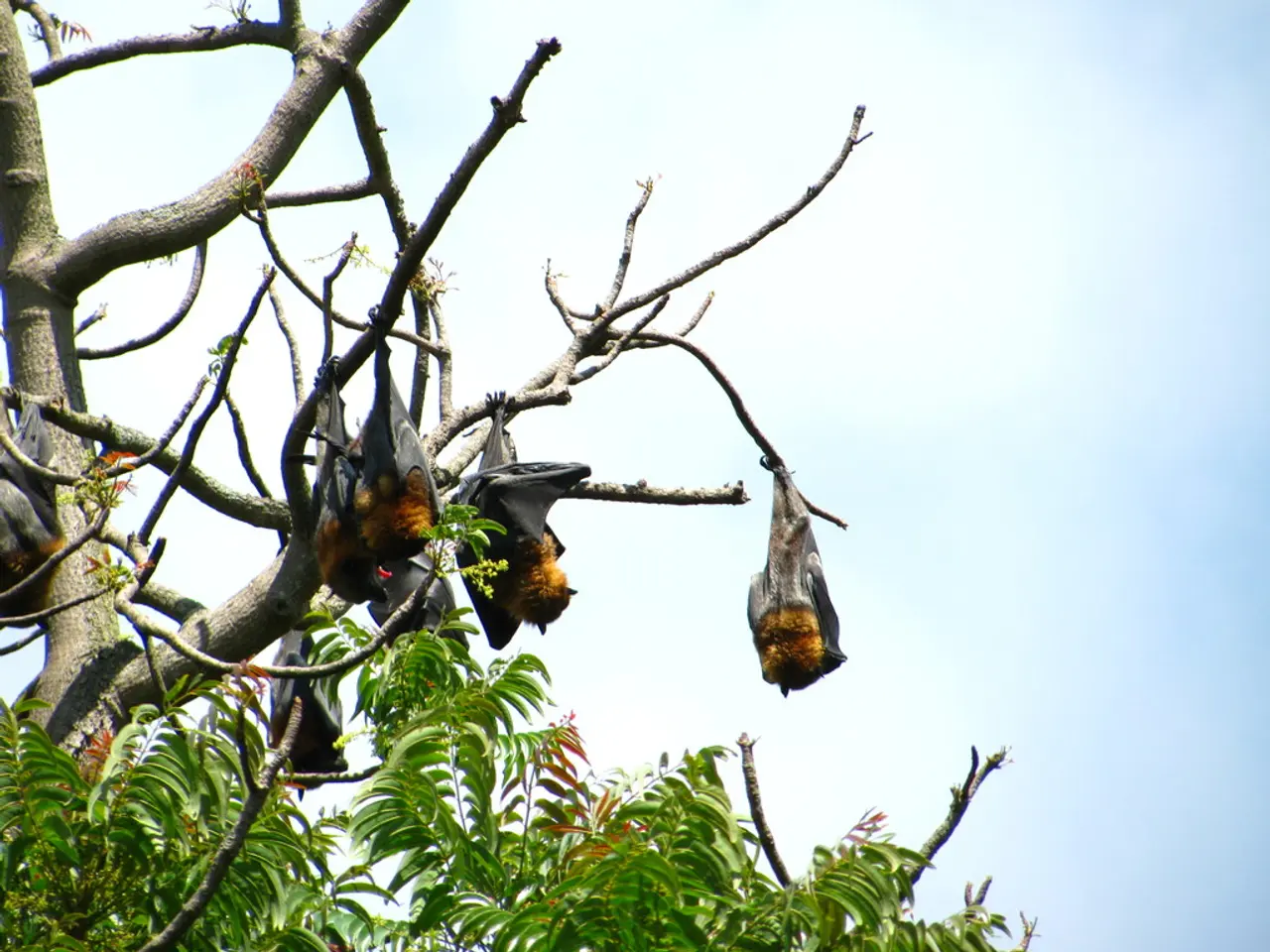Exploring the subterranean world: Unveiling the allure of bats
In the heart of Germany, Dr. Simon Ripperger's fascination with bats, nurtured during a sojourn in Costa Rica, has led to groundbreaking research at the Bayerisches Landesamt für Umwelt (Bavarian State Ministry of the Environment and Consumer Protection).
The environmental contribution of bats, as pollinators and insectivores, is crucial for maintaining ecological balance. Bats in tropical rain forests, for instance, pollinate flowers, disperse seeds, and control insect populations, making their protection vital for biodiversity and the health of ecosystems.
Historic beer cellars, like many other underground structures, offer unique habitats for bats, providing shelter and roosting sites. Preserving these habitats is essential for maintaining bat populations, as these sites offer architectural features and minimal human disturbance, providing stable environments for bat colonies.
Dr. Ripperger's research focuses on understanding the demands bats place on their environment, investigating bat hibernation habits, and monitoring the occurrence and development of various species. Over the past 15 years, more than 1,000 basements in northern Bavaria, many of which are historic beer cellars, have been investigated, revealing the presence of over 50,000 bats.
Climate change and human activities can threaten bat habitats. Dr. Ripperger's research aims to mitigate these impacts and ensure the long-term survival of bat species in these unique environments. The findings from this research enable Dr. Ripperger to develop targeted protection measures, which can be used to protect bats in similar habitats worldwide.
The Bayerisches Landesamt für Umwelt has been at the forefront of protecting native species, including bats. The organisation's efforts are not limited to conservation but also extend to conducting basic research and implementing regulatory measures for the protection of these vital creatures.
Dr. Ripperger's journey into bat conservation began with biology studies in Ulm, which led to a year-long stay in Costa Rica. His passion for bats and his commitment to their conservation have since driven him to make significant contributions to the field, ensuring the survival of these essential creatures in unique habitats like historic beer cellars.
- Dr. Simon Ripperger's fascination with bats, nurtured during a sojourn in Costa Rica, has led to groundbreaking research at the URL: 'deutschland.de', particularly focusing on their ecological role in science.
- In science, there's increasing recognition of the crucial role bats play as pollinators and insectivores, contributing to the maintenance of ecological balance.
- During sleep, bats in tropical rain forests pollinate flowers, disperse seeds, and control insect populations, making their protection vital for biodiversity and the health of ecosystems.
- Workplace-wellness initiatives could consider the positive impact of more bat-friendly workplaces on mental-health and overall medically-healthy employees.
- Chronic-diseases, such as certain respiratory-conditions, digestive-health issues, eye-health concerns, and neurological-disorders, may be less prevalent in areas with active bat colonies, suggesting a possible connection to their presence.
- In efforts to maintain the hearing of people with medical-conditions, workplace or home hearing solutions could be designed with bat resonance in mind for a harmonious coexistence.
- Health-and-wellness enthusiasts might find it interesting to know that bats play a crucial role in maintaining our ecosystem's health, highlighting the interconnectedness of nature and human wellness.
- Fitness-and-exercise regimes could take a cue from the endurance and physical prowess of bats to inspire new forms of energizing and invigorating workouts.
- Sexual-health and overall reproductive health could potentially benefit from those who study the impact of environmental factors, such as industrial pollutants, on bat populations and their potential impacts on human health.
- Autoimmune-disorders and other such conditions might find potential treatment avenues in the study of bat immune systems, as understanding their resilience could provide insights into human immune functionality.
- Climate-change efforts should consider the critical role of bats in controlling insect populations that could contribute to the spread of diseases, illustrating the environmental, medical, and public health implications of our actions.
- Manufacturing industries could offset their carbon footprint by implementing bat-friendly practices, helping combat climate change while supporting biodiversity and the health of ecosystems.
- Mental-health initiatives, especially in men's-health, could explore the therapeutic benefits of interacting with and observing bats to promote well-being and stress reduction.
- Skin-care companies catering to skin-conditions might integrate bat secretions—known for their potential healing properties—into their product line for innovative, eco-friendly solutions.
- Therapies-and-treatments for aging-related health issues could utilize research findings related to bat hibernation and longevity to develop new methods for extending the human lifespan.
- Women's-health research could focus on understanding the different ways bats care for their young, applying the lessons learned to further strengthen maternal and child health care.
- Parenting tips and advice could be derived from the way bats raise and nurture their young, providing insights into effective, emotionally intelligent child-rearing strategies.
- Weight-management strategies could consider the energy-efficient flight techniques of bats, aiming to adopt similar principles for reducing energy consumption in daily activities.
- Cardiovascular-health is vital for overall wellness, and understanding the cardiovascular demands of bats could potentially lead to new breakthroughs in human cardiology and improving heart health.
- With a comprehensive understanding of bat habitats and the impact of human activities on their population, the industry could develop sustainable practices benefiting both economic growth and bat conservation.
- Medicare provision for citizens could consider the long-term benefits of focusing on preventative medicine, including bat conservation, to reduce costs associated with chronic diseases and medical interventions.
- CBD, a popular wellness product, might be further researched in relation to bat secretions for potential synergies and alternative medicinal applications.
- Neurological-disorders could potentially be better understood by studying bat neurology and comparing the structures and functions of their brains to those of humans.
- Environmental-science students should look into the role of bats in controlling pollinators, helping manage the negative impacts of climate change on food-and-drink production and agricultural practices.
- Financing and investing in sustainable energy sources should also incorporate bat conservation initiatives, as bats help control pests that can damage renewable infrastructure.
- Energy-efficient homes and buildings, a critical component of the home-and-garden sector, should consider potential bat habitats to create energy-saving, eco-friendly solutions for everyone.
- The interplay between technology, such as artificial-intelligence and data-and-cloud-computing, could be harnessed to streamline the processes of bat research and conservation, paving the way for future environmental breakthroughs, and fostering a stronger relationship with nature.




